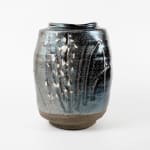Shimizu Uichi 清水 卯一 Japanese, 1926-2004
(h) 26.6 x (w) 19 x (d) 17.7cm
Designated LNT in 1985
Further images
-
(View a larger image of thumbnail 1
)

-
(View a larger image of thumbnail 2
)

-
(View a larger image of thumbnail 3
)

-
(View a larger image of thumbnail 4
)

-
(View a larger image of thumbnail 5
)

-
(View a larger image of thumbnail 6
)

-
(View a larger image of thumbnail 7
)

-
(View a larger image of thumbnail 8
)

Shimizu Uichi (1926-2004) was designated for his contributions using iron-containing glazes (tetsu-yu). His predecessor for this title was the great Ishiguro Munemaro (1893-1968), one of the original Living National Treasures designated in the 1955 group. Iron containing glazes suggests black or brown colouration but Shimizu Uichi created orange, white and celadon shades as well. As with the glazes used by Shoji Hamada iron containing glazes date back to Northern Song Dynasty wares but in Shimizu’s hands they were modernised and used on graceful forms to create a different way of using these glazes. The three vases in this exhibition are late works but demonstrate the power, confidence and skill of a master potter. His manipulation of the glaze disrupts its normal role and makes it the statement of the piece. Here technique is taken for granted and the expression of an idea is the prime objective.
Alongside Hayashi Yasuo, Shimizu Uichi was a part of the avant-garde ceramicist group “Shikokai 四耕社” in the Kyoto scene during the post-war period in the 1950s and 60s. The movement permitted potters to re-conceptualize pottery outside of industry traditions of Japanese ceramics, which had been dominated by the idea that lineage- rather, potters who were children of pottery masters- granted credibility to ceramicists. Shimizu’s frank boldness rippled through the ceramics world in Japan and created fresh aesthetic values, tenets, and precedents for what permitted a ceramic art object.







